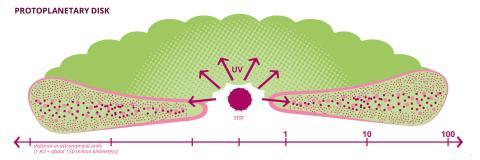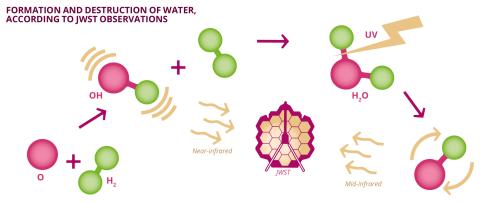
Protoplanetary disks: in the eye of the James Webb Space Telescope
This article was originally published in L'Édition n°24.
That was two years ago. On 11 and 12 July 2022, the James Webb Space Telescope (JWST) revealed its first infrared images of the Universe, including "the deepest and sharpest ever produced", according to NASA. This marked the start of scientific operations for the space observatory. It has made a steady stream of discoveries since then, notably regarding protoplanetary disks, the disks of gas and dust where planets form.
The JWST was intended to usher in a new era in astronomy. Two years after delivering its first images, it already seems to have lived up to its promise in the eyes of the scientific community studying its data. "We have currently accumulated more than 150 hours of JWST observation. This represents around 50 protoplanetary disks observed, an exceptional data set," enthuses Benoît Tabone, researcher at the Institute of Space Astrophysics (IAS - Univ. Paris-Saclay/National Centre for Scientific Research, CNRS).
Protoplanetary disks are one of the targets that the JWST has focused on since it was commissioned. They are at the heart of the MINDS (MIRI mid-Infrared Disk Survey) observation programme, which brings together an international team of scientists including Benoît Tabone and Alain Abergel from IAS, and Pierre-Olivier Lagage from the Paris-Saclay Astrophysics, Instrumentation and Modelling Laboratory (AIM - Univ. Paris-Saclay/ CNRS/CEA/Université Paris Cité).
Both the AIM laboratory and the IAS are part of the European consortium responsible for the design, construction and assembly of one of the JWST instruments, the MIRI (Mid-InfraRed Instrument) spectro-imager. As a result, they benefit from Guaranteed Time Protoplanetary disks In the eye of the James Webb Space Telescope Observations (GTO) programmes, to which the MINDS programme belongs. This programme aims to explore protoplanetary disks located around stars ranging from the mass of our Sun (nearly 2 x 1030 kg) to masses ten times smaller.
From molecular clouds to the birth of stars and planets
Scientists are so interested in protoplanetary disks because they are an essential link in the life cycle of stars and the formation of planetary systems. It is within these disks that planets are born.
It all begins in molecular clouds, immense clouds composed of a dense mixture of gas and dust. Under the effects of a disturbance, certain parts of the cloud may lose their stability and collapse in on themselves. They then produce star embryos called protostars. "These objects are only a few tens or even a hundred thousand years old. For a star, this represents the equivalent of just a few hours of human life," explains Benoît Tabone.
At this stage, the protostar is still surrounded by a cluster of gas and dust, which continues to collapse in on it, forming a very dense cocoon. The embryo grows over the following hundreds of thousands of years as it feeds on the collapsing matter. The temperature and pressure inside the protostar gradually rise until nuclear fusion reactions begin at its core, and the embryo becomes a star. It is during this same process that the protoplanetary disk is formed from the mixture of gas and dust that orbits the young star.
According to observations, this disk can reach a diameter of a few hundred to a thousand astronomical units (an AU is equivalent to around 150 million kilometres) for a mass of 0.001 to 0.3 solar masses. But its structure is not uniform, as its thickness varies according to the distance from the central star, giving it a bow-tie shape. Its density and temperature also fluctuate depending on this distance. Scientists distinguish between the inner disk, closest to the star, and the outer disk.
A protoplanetary disk survives for several million years, during which time planets are formed. This same chain of events was also at the origin of the Sun and the solar system. Around 4.6 billion years ago, a molecular cloud collapsed in on itself, giving rise to an embryonic sun and a protoplanetary disk. Then matter gradually aggregated to form the Earth and the seven other planets in the solar system.
But how exactly do planets form in a disk? Under what conditions? And why do some regions produce rocky planets like Earth, while others produce gas giants like Jupiter? This is what astrophysicists are now trying to determine by studying disks.
The JWST reveals disk material in detail
The concept of the protoplanetary disk as the cradle of planets dates back to the 18th century. But it was not until the end of the 20th century that scientists gained any real insight into the structure of these disks. After initial data in the millimetre range, in 1992, Hubble became the first telescope to spatially resolve disks around the stars of a nebula located a thousand light-years (9.46 x 1012 km) from Earth.
This accelerated with the launch of the ISO (Infrared Space Observatory) telescope in 1995, followed by Spitzer in 2003, and the deployment in 2011 of ALMA (Atacama Large Millimeter Array), the array of antennas installed in Chile's Atacama Desert. "Planet formation is a very active subject, with many theories. It's only in the last ten years that telescopes have become powerful enough to scan the disks closest to us, at least 300 light-years away," comments Benoît Tabone. Like ISO and Spitzer, whose mission ended in 2020, the JWST operates in the infrared range, down to wavelengths of 27 micrometres (μm), but with 100 times greater sensitivity. This should usher in a new golden age of protoplanetary disk observation. "The JWST's strength lies in its ability to observe hotter gas (100-500°C) in the disk region close to the star, including regions where Earth-like planets are expected to form," explains the astrophysicist.
The strength of the JWST lies in its MIRI instrument. This technological gem comprises two separate components, the MIRIm imager and a medium-resolution integral field spectrometer, MRS. A veritable "chemical machine", this instrument analyses the molecules in the disk that modify the light emitted by the star. The result is an emission spectrum in which each molecule has its own characteristic signature."Thanks to the MRS, all the lines in the spectrum are much finer, so we can see much more detail and access all the molecular content of the gas," confirms Benoît Tabone. The case of GW Lup, a young low-mass star located around 500 light-years away in a region called Lupus 1, provided the first example of the JWST instrument's capabilities.
By analysing its emission spectrum, the MINDS team gained insight into the chemical and physical conditions that exist within the inner disk surrounding the star. It detected the presence of carbon dioxide (CO2), water (H2O), hydrogen cyanide (HCN), acetylene (C2H2) and hydroxyl (OH). It also observed an isotope of carbon dioxide, 13CO2. A first in a protoplanetary disk.
Another more surprising case from the same programme is that of J160532, a star ten times less massive than the Sun, located around 500 light-years away in the Scorpio-Centaurus group of stars. When astronomers turned the MIRI spectrometer onto the disk surrounding the star, they obtained a rather unusual spectrum. "We discovered that the disk is surprisingly rich in hydrocarbons," explains the IAS researcher.
The spectrum revealed a very large quantity of acetylene (C2H2), as well as two molecules previously unknown in disks: benzene (C6H6) and diacetylene (C4H2). Conversely, water and carbon dioxide, which are regularly detected in other disks, appeared in small quantities.
Which disk for which planetary system?
All these discoveries are invaluable to astronomers. Determining the chemical composition of disks is crucial for a better understanding of the planet formation process. This could be used, for example, to establish a link with other parameters, such as the composition of exoplanet atmospheres. "Imagine revealing a region very rich in carbon in a certain area of the disk, around all the stars, and at the same time finding gaseous planets that are very rich in carbon. This would indicate that these planets accreted their mass in this precise region," explains Benoît Tabone. But the situation seems far from simple.
One of the findings of the MINDS programme is that disks actually have a surprisingly diverse chemical composition. "When we look at the emission spectra of two disks, they are always different. While one is rich in hydrocarbons and poor in oxygen, the other is poor in gas but rich in silicate grains... The story is quite different each time." Now, different disks necessarily imply different planetary systems. So how do we know which disk produced which system of planets? This is what scientists are hoping to understand using a statistical approach.
"From the observed sample, the aim is to gauge and quantify the differences to try and extract similarities or regularities in the properties of these disks. For example, are the disks around low-mass stars generally very rich in hydrocarbons? Are the disks around higher-mass stars richer in oxygen? The statistical approach will help us to establish links," explains the astrophysicist.
An "interstellar laboratory" in the Orion Bar
In the eye of the JWST, another disk acts as an "interstellar laboratory". It is called d203-506 and is located in the Orion Bar, 1,350 light-years away, in one of the closest and therefore most studied star nurseries to Earth. Object d203-506 differs from the above-mentioned disks in one important respect, namely that it is what astronomers call a proplyd, an irradiated protoplanetary disk. This is because it is exposed to the powerful ultraviolet radiation emitted by the massive stars of the nearby Trapezium Cluster. These stars are 30 times more massive and 200,000 times brighter than the Sun. In other words, they impose extreme conditions on every object in their vicinity.
These regions exposed to the radiation of massive stars are the target of another JWST programme: PDRs4All (or Radiative feedback from massive stars as traced by multiband imaging and spectroscopic mosaics), of which Émilie Habart, Head of the IAS Astrophysics of Interstellar Matter (AMIS) team, is one of three co-PIs (Principal Investigators). During the telescope's first five months of operation, scientists captured data within the Orion Bar. And d203-506 appeared in a new light.
In this case, it is not the disk itself that the JWST is observing, but the "photoevaporated" gas coming out of it. "Because of the UV radiation from the massive star, some of the gas is torn from the disk and escapes in the form of a wind," explains Marion Zannese, PhD candidate in the IAS AMIS team involved in the PDRs4All programme. And this wind escapes quickly, very quickly. Analysis of the dihydrogen present shows that the d203-506 disk, whose estimated mass is ten times that of Jupiter (1.9 x 1029 kg), loses the equivalent of 10-8 to 10-6 solar masses per year. In other words, the disk would lose almost all its gas in less than a million years. With such a loss rate, the disk will probably not have time to form a gas giant planet like Jupiter," says the astrophysicist. This example suggests that massive stars play a significant role in planet formation processes within the disks they irradiate.
The equivalent of a terrestrial ocean destroyed and formed per month
The gas wind captured by the JWST instruments also provides further information on the reactions taking place within d203-506. "Wind material does not have the same characteristics as disk material. Its density is much lower and its temperature is probably different too. But the atoms present are the same as in the disk."
This is where the study of this gas comes in. By dissecting the infrared light spectra delivered by MRS, the PDRs4All team has identified a water cycle. "It was not really the water we were looking at," says Marion Zannese, who led the work. "We detected a molecule characteristic of the presence of water in this disk: hydroxyl (OH)."
In addition to this single molecule, a two-stage reaction was revealed. When a water molecule (H2O) is photodissociated - destroyed by UV radiation - it produces an OH molecule in a state of extreme excitation. "This molecule is spinning so fast that it is ready to break, too. Its excitation then subsides level by level."
During this process, the OH molecule produces a very characteristic spectrum, which is precisely what the wind from d203-506 exposes. "This is something we have detected elsewhere, but it is the first time we have observed particularly excited lines with the JWST." As well as confirming this reaction, the results quantify the amount of water destroyed per unit of time. "Based on the intensity of the lines, we calculated that the equivalent of a terrestrial ocean, i.e. approximately all the water molecules in the Earth's oceans (5 x 1046), is destroyed in this disk every month," explains Marion Zannese.
A second OH spectrum, captured in the near infrared, also demonstrated a particular state of excitation, but the scientists had yet to identify which one. Collaboration with Spanish physicists provided the missing pieces. "These scientists performed calculations to determine what quantum state hydroxyl is in when it forms in the gas phase. In astrophysics, these were calculations that we were incapable of doing," emphasises the PhD candidate. Once the calculations were completed, there was no doubt that this characteristic spectrum reflected a reaction between oxygen and molecular dihydrogen (H2), in other words, the first step towards the formation of a water molecule. Once quantified, the reaction appeared more important than the photodissociation phenomenon. In conclusion, if the equivalent of a terrestrial ocean appears destroyed every month within the d203-506 disk, it would also be reformed there. This discovery has implications for the formation of planets within disks. It could also help us to better understand the origin of water on Earth, and in particular the abundance of deuterium 2H - a hydrogen isotope - in terrestrial oceans.
Combining specialties to exploit JWST data
Showing what the telescope is capable of, and developing tools to help the scientific community exploit its data are the main objectives of the JWST's initial Early Release Science (ERS) programmes, of which PDRs4All is a part. While the detection of this water cycle opens up a new way of characterising the matter present in disks, it also demonstrates the importance for astrophysicists of working closely with specialists from other disciplines.
At the Molecular Science Institute of Orsay (ISMO - Univ. Paris-Saclay/CNRS), scientists are also working on JWST data. "We conduct laboratory experiments designed to reproduce conditions in space, so that we can analyse the observations made by telescopes," confirms Emmanuel Dartois, Head of the Molecular Systems, Astrophysics and Environment (SYSTEMAE) team at ISMO.
Thanks to these experiments, Bérenger Gans, Marie-Aline Martin, Ugo Jacovella and Laurent Couvert from ISMO, as part of an international collaboration, are contributing to another discovery in the d203-506 disk. At the heart of this study is a peculiar band that appears around 7 μm in the emission spectrum of the disk. After running models and ruling out all the classic molecules that fall into this spectral region, the verdict is that it is the methyl cation (CH3+). "The CH3+ spectrum was not known. It had not been precisely measured in the laboratory. So we had to work to confirm that this was a plausible hypothesis and then make a fine attribution," asserts Emmanuel Dartois.
This is the first time the CH3+ cation has been observed outside the solar system. "Detecting this molecule in the interstellar environment was a real turning point, because we have long believed that CH3+ was the origin of many other hydrocarbon species," says Marion Zannese. "This very interesting detection enables us to check whether all gas-phase hydrocarbons are indeed formed from this species."
A history rebuilt brick by brick
Methyl cation, benzene, a water cycle... After just two years of data collection, the JWST has provided a rich harvest of discoveries about protoplanetary disks and planet formation. But the space telescope takes the story back a little further. "The JWST allows us to probe deeper into regions and observe stages that we had not seen before," adds Emmanuel Dartois, who is involved in another programme, Ice Age, whose PI is Melissa McClure (Netherlands). This programme focuses on the cold dust grains present in the molecular cloud during the star formation process, i.e. before the protoplanetary disk appears. "With JWST spectroscopy, for example, we can remotely measure the size of the icy grains in the cloud."
These grains may measure barely a micron, but the parameter is important. "Grain growth changes many things within the molecular cloud, including in planet formation. This is the aim of our research, namely to determine the initial conditions so we can better understand the evolution to the next stages." The entire history of stars and planetary systems in the Universe is being reconstructed brick by brick thanks to the JWST and its instruments. "And this is just the beginning," concludes the researcher.
References:
- Tabone et al., A rich hydrocarbon chemistry and high C to O ratio in the inner disk around a very low-mass star, Nature Astronomy, 2024.
- Berné et al., A far-ultraviolet driven photoevaporation flow observed in a protoplanetary disk, Science, 2024.
- Zannese et al., OH as a probe of the warm water cycle in planet-forming disks, Nature Astronomy, 2024.
- Dartois et al., Spectroscopic sizing of interstellar icy grains with JWST, Nature Astronomy, 2023.

This article was originally published in L'Edition No. 24.
Find out more about the journal in digital version here.
For more articles and topics, subscribe to L'Édition and receive future issues:
Subscribe


